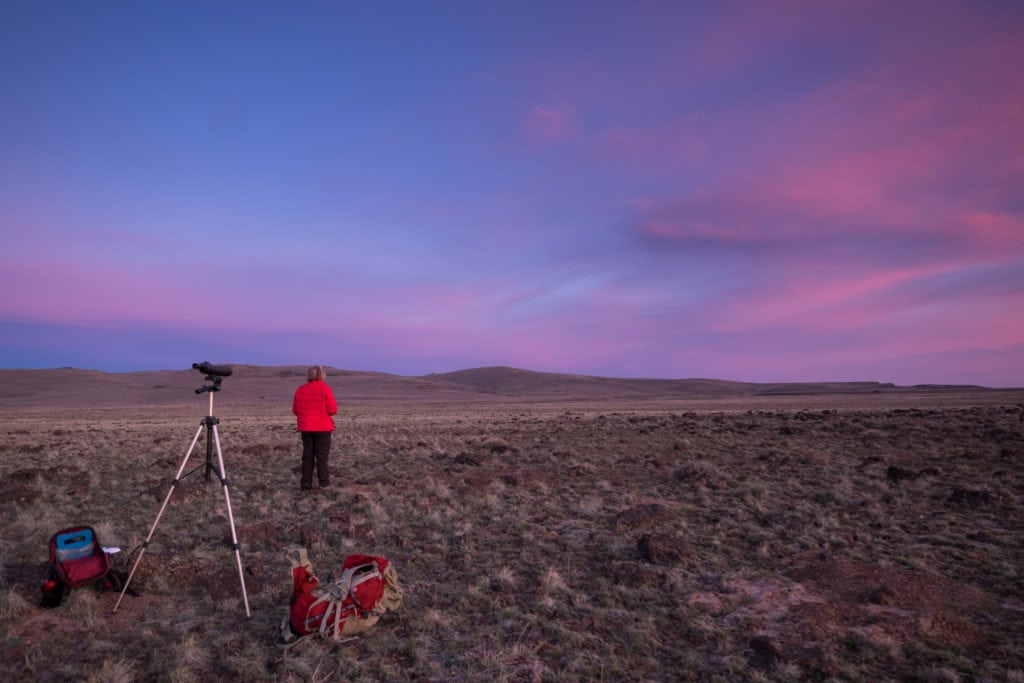Canceled: Hart Mountain Lek Monitoring
Devlin Holloway
Organizer: Jeremy Austin
Start Date: 4/02/2019
End Date: 4/05/2019
Region: Greater Hart-Sheldon Region
Difficulty Rating: 3 out of 5
Maximum Group Size: 5 participants
About the place
Hart Mountain National Antelope Refuge (NAR) was established in 1936 to protect the range and breeding grounds of pronghorn antelope and other wildlife species. Located in southeastern Oregon in the northern Great Basin, Hart Mountain is a wildlife mecca for over 300 species including migrating waterfowl, bighorn sheep, and sage-grouse. Hart Mountain and the adjacent lands have been recognized as one of six key areas important to the long-term survival of Greater Sage-Grouse.
About the stewardship work
Sage-grouse depend on sagebrush for winter survival and they are considered an indicator species for the overall health of sagebrush habitat across the West.
You will work in groups of two for safety reasons as well as the benefits of having more than one person to take turns with different tasks such as using the spotting scope or recording the data. Groups will drive to the work site, then use GPS units to navigate cross-country in the dark to their designated lek observation point, being careful of unseen hazards such as brush and uneven terrain along the way.
Once relatively close to a traditional sage-grouse mating grounds, known as a lek, volunteers will be able to use the unique sounds that the male sage-grouse make to zero in on the lek. As day breaks, volunteers will use spotting scopes provided by the U.S. Fish and Wildlife Service (USFWS) and ONDA to count the number of individual males and females.
ONDA will provide all necessary training in order to conduct the lek counts so no previous experience is required.
Trip timeline
- Thursday, April 2, 2 p.m: We will all gather at the Hart Mountain NAR Headquarters. Arriving at this time is important because it allows time for the U.S. Fish and Wildlife Service orientation, gear assignments and answering questions. We will be going to bed early in preparation for the early mornings!
- Friday, April 3: Rise and shine at around 4 a.m.! Volunteers will be divided into three groups with approximately two people per group. All leks will involve at least a short drive and a hike ranging from 1 to 3 miles in the dark. Due to the early start, volunteers are usually done with the count and back to the bunkhouse by 10 a.m. Afternoon will consist of scouting out the locations of the next day’s leks and, time and energy permitting, possibly a leisurely hike or a soak in the hot springs (or a nap).
- Saturday, April 4: Following the same plan as the day before, we will rise early, hike out to the leks in the dark, count sage-grouse, return to the bunkhouse, and scout tomorrow’s lek locations.
- Sunday, April 5: One last morning of getting up before daybreak. After monitoring leks in the morning, we’ll return to the bunkhouse to pack up personal gear and clean and be ready to head home before noon.
Camp
We will be staying at a USFWS bunkhouse at Hart Mountain NAR Headquarters. It is modern, heated and roomy, with 13 total beds in seven rooms, a full modern kitchen with some utensils, and a bathroom with hot showers.
Difficulty
Very early working hours, below freezing temperatures, hiking in the dark on uneven terrain.
Participant responsibilities
Participants are responsible for their own food, but we will likely coordinate a group dinner or two for fun. Be sure to bring sleeping needs such as sheets/blanket or a sleeping bag and a pillow and a towel for the shower. Sturdy off-trail ankle-high boots are recommended for this trip. A good working headlamp with fresh batteries is a must. You will need a vehicle capable of driving on graded gravel roads and possibly snowy conditions (all-wheel drive recommended), for transportation to and from Hart Mountain. Carpooling can be arranged after registration.
Gear provided
USFWS vehicles for transportation to work sites, data sheets, Rite in the Rain notebooks, pencils, GPS units, SPOT emergency beacon and USFWS radios (for medical or logistic emergencies only), first aid kit, spotting scopes and some binoculars
Registration
An ONDA registration application and medical form are required for this trip. Check the box next to each trip you would like to attend. You only need to fill this form out once per year.
What happens next?
You will receive a confirmation email within 10 working days of submitting your form. The confirmation email will provide information regarding which trips you are on the “participant list” for, and which trips are full, and therefore you have been placed on the “waitlist.”
Six weeks before the start of the trip, the trip leader will send out an RSVP to make sure everyone is still able to participate. Based on RSVPs, open spaces will be backfilled with people from the waitlist.
Three weeks before the trip start date, registered and confirmed participants will receive driving instructions, maps, carpooling options, and additional information in an email sent by the trip leader
If you have any questions in the meantime, please don’t hesitate to contact the trip leader.
Your Trip Leader
This trip will be led by Jeremy Austin. If you have questions, you can contact him at (541) 330-2638, ext 310 or email jeremy@onda.org.
Meet JeremyRestoring Lands and Waters
Oregon Natural Desert Association sustains and enhances the health of Oregon’s high desert through stewardship and restoration. ONDA takes a holistic approach to conservation in Oregon’s high desert, pairing on-the-ground […]
Read More